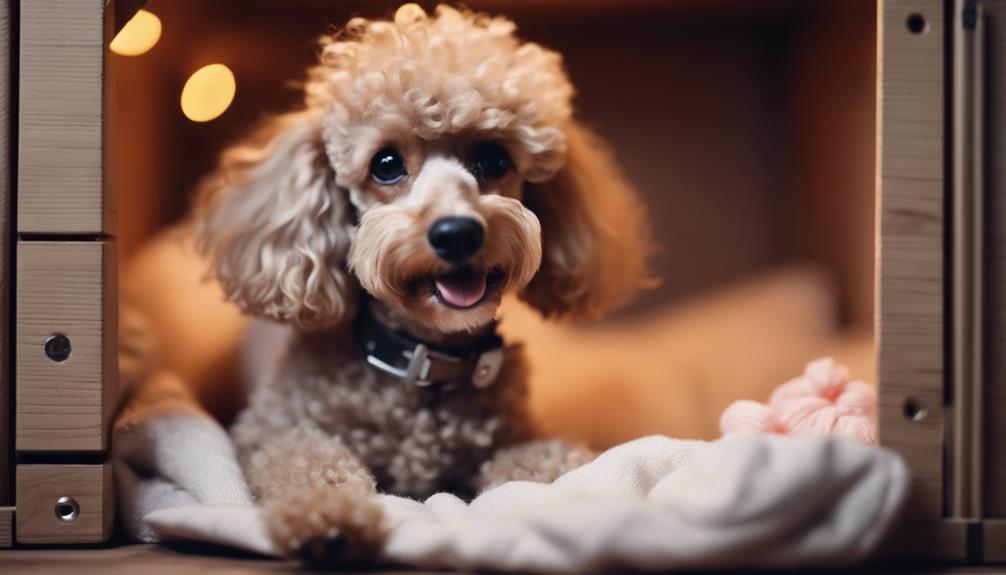When it comes to crate training your poodle, you might be surprised by the peace of mind it can bring to both you and your furry companion. The benefits extend beyond just creating a designated space for your pet. By understanding the intricacies of this training method, you can establish a strong bond with your poodle and help them navigate various situations with ease. Stay tuned to discover how crate training can revolutionize your poodle's routine and well-being.
Key Takeaways
- Crate training aids in housebreaking and prevents destructive behaviors in Poodles.
- It provides a secure and comfortable den-like space for rest and relaxation.
- Consistent crate training routines help manage separation anxiety and establish good habits.
- Using positive reinforcement and appropriate crate sizes are essential for successful training.
Benefits of Crate Training for Poodles

Crate training your Poodle offers numerous advantages that cater to their natural instincts and promote positive behavior. This method is particularly beneficial for housebreaking your Poodle, as it helps them learn bladder control and develop good potty habits. By using a crate, you provide your Poodle with a designated space that mimics their den-like preferences, making them feel secure and comfortable. Additionally, crate training aids in preventing destructive behaviors like chewing or excessive barking, as it gives your Poodle a safe retreat when needed.
Moreover, when it comes to travel, crate training is advantageous for Poodles. Having a familiar space during journeys can help reduce their stress and anxiety, ensuring a smoother experience for both you and your furry companion. Overall, crate training not only serves practical purposes like housebreaking and managing destructive behaviors but also contributes to your Poodle's mental well-being and overall happiness.
Importance of Crate Training Poodles
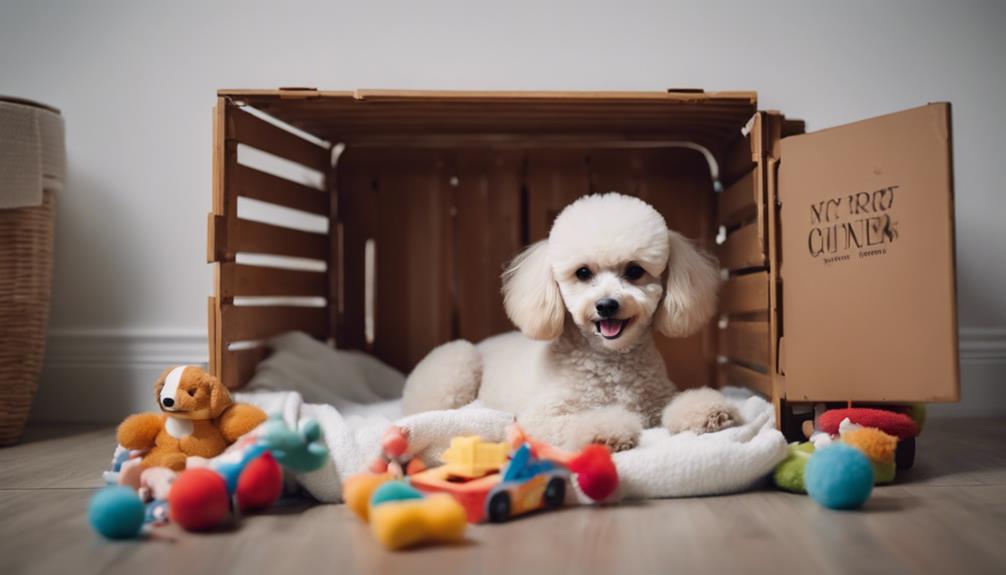
Ensuring the well-being and proper training of your Poodle encompasses providing a safe and secure environment for their rest and relaxation needs. Crate training plays a pivotal role in the development and behavior management of your beloved pet. Below is a table highlighting the importance of crate training Poodles:
| Importance of Crate Training Poodles |
|---|
| Helps in housebreaking puppies |
| Manages separation anxiety |
| Establishes a routine for poodles |
| Prevents destructive behaviors |
| Provides a secure environment |
Crate training aids in the process of house training your puppy, allowing them to understand boundaries and schedules. It also assists in managing separation anxiety by giving your Poodle a safe space when you're away. Moreover, the sense of security a dog crate provides can prevent destructive behaviors and offer a haven during stressful situations. By incorporating crate training into your routine, you're not only ensuring your Poodle's well-being but also fostering a confident and well-adjusted companion.
Advantages of Using a Crate

To foster a well-adjusted and content Poodle, understanding the advantages of utilizing a crate is essential in creating a secure and beneficial environment for your pet. Crate training provides your Poodle with a secure den-like space, offering a designated area for rest and relaxation. Additionally, using a crate aids in housebreaking your Poodle efficiently, helping establish good bathroom habits. Crates also play a crucial role in preventing destructive behaviors when you're unable to directly supervise your pet, keeping both your Poodle and your belongings safe. Furthermore, crates offer a sense of security and comfort, especially during travel or emergencies, providing a familiar space in unfamiliar situations. By incorporating proper crate training, you can reduce stress and anxiety for your Poodle, ensuring a calmer and happier pet in various circumstances. Embracing the benefits of crate training will not only benefit your Poodle but also enhance the bond between you and your furry companion.
Benefits for Poodles of All Ages

For Poodles of all ages, having a designated den-like space through crate training offers a secure and comforting environment for rest and relaxation. Here are the benefits of crate training for poodles of all ages:
- Improved Bladder Control: Crate training helps poodles learn bladder control, which is especially crucial for puppies.
- Effective Housebreaking: It aids in housebreaking, teaching poodles where it's appropriate to relieve themselves.
- Safe Haven for Seniors: Senior poodles with health issues benefit from a crate as a restful place to retreat.
- Convenient Travel Companion: Crate training is beneficial during travel, providing a familiar and secure space for poodles.
- Anxiety Management: It helps manage anxiety-inducing situations for poodles of all ages, promoting their overall well-being.
Crate training offers numerous advantages for poodles, regardless of age, by assisting in bladder control, housebreaking, providing a safe haven, facilitating travel, and managing anxiety.
Tips for Successful Crate Training
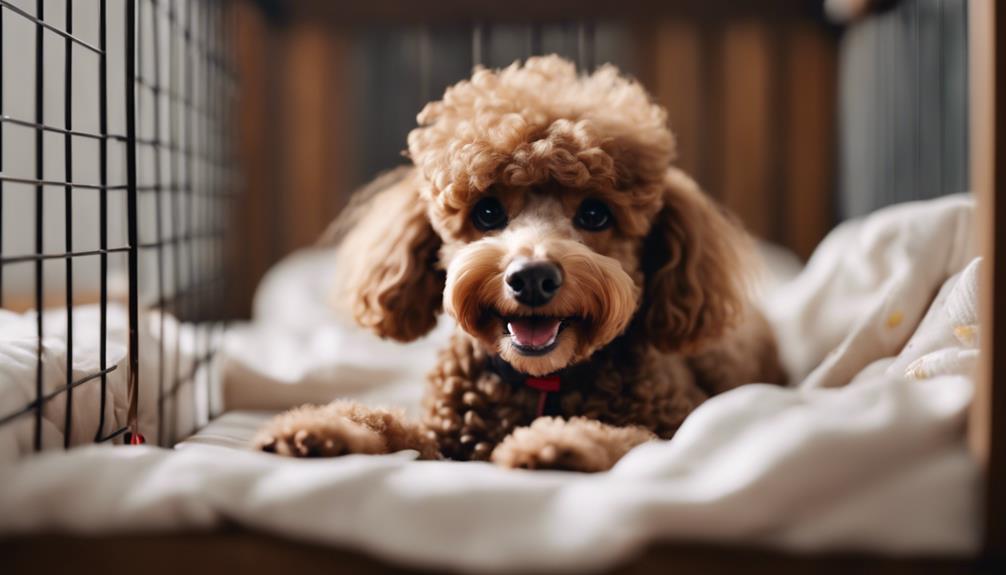
When embarking on crate training for your poodle, remember to use high-value treats or meals to create a positive association with the crate during the training process. Positive reinforcement is crucial in making the crate a comfortable and welcoming space for your furry friend. Gradually increase the time your poodle spends in the crate, ensuring it is a positive experience each time. Consistency is key in crate training; stick to a routine to help your poodle understand expectations. Consulting with a professional dog trainer can provide valuable insights and personalized guidance for effective crate training. Make sure the crate is appropriately sized – allowing your poodle to stand, turn around, and lie down comfortably is essential for their well-being. By incorporating these tips, your poodle will learn to see the crate as a safe and secure den, making crate training a positive experience for both you and your canine companion.
Choosing the Right Crate Size
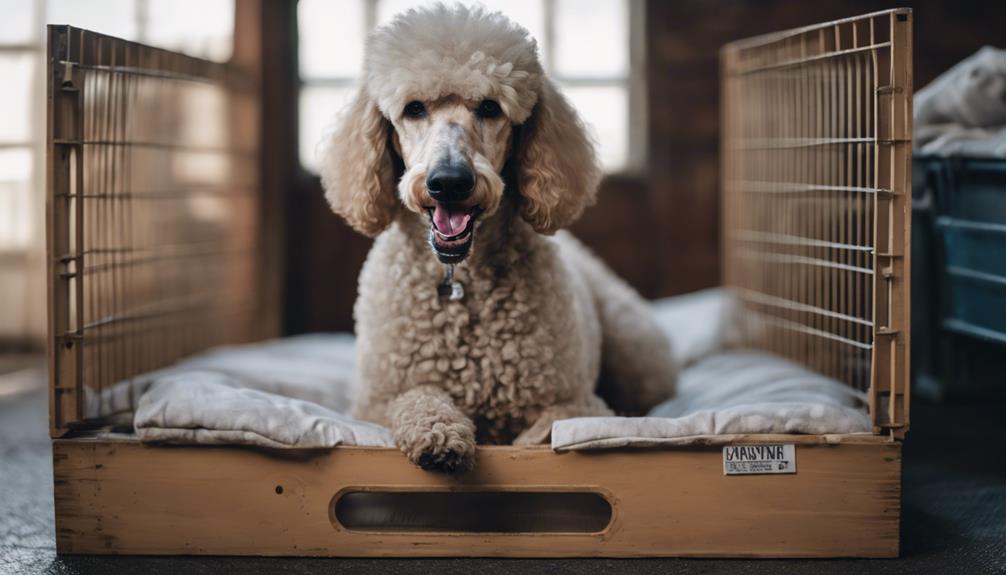
Choosing the right crate size for your Poodle is crucial for their comfort and well-being during crate training. Here are some tips to help you select the appropriate crate size:
- Allow for Movement: The crate should be large enough for your Poodle to stand up, turn around, and lie down comfortably.
- Avoid Oversized Crates: Especially during potty training, overly large crates can hinder your Poodle from establishing good habits.
- Establish Routine: Proper crate size is essential to set routines and ensure your Poodle feels secure in their designated space.
- Seek Guidance: Consult experts or breed-specific guidelines to determine the right crate size for your Poodle.
- Success in Training: Choosing the correct crate size is vital for successful crate training and the overall well-being of your Poodle.
Setting Up the Crate Properly
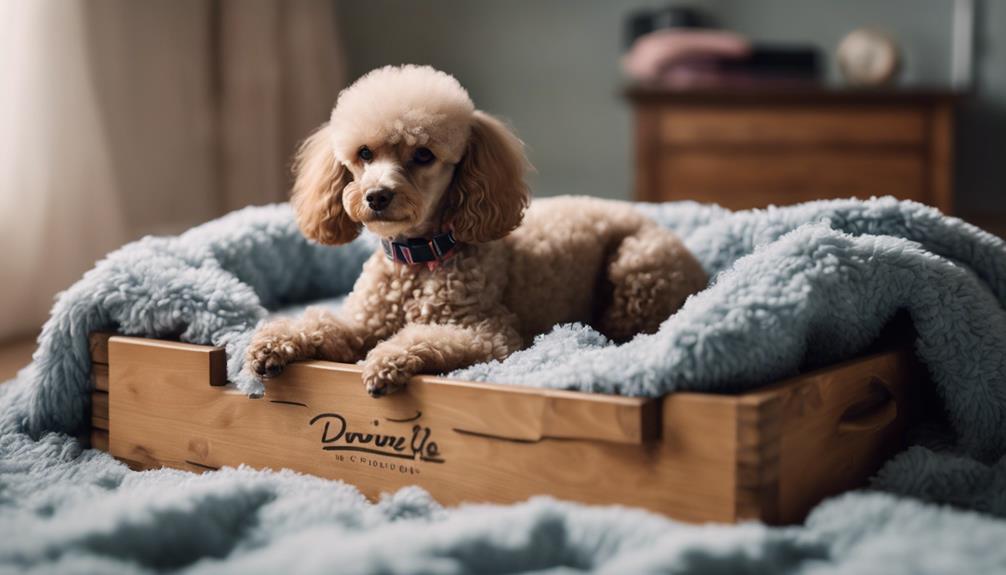
To properly set up the crate for your Poodle, ensure it is the right size for them to stand up, turn around, and lie down comfortably. Selecting a crate that matches your Poodle's size is crucial for their comfort and safety. For Poodle puppies, consider using a crate divider to adjust the space as they grow. Inside the crate, place a soft bedding or mat where your Poodle can rest peacefully. Adding familiar toys or treats can help make the crate a positive space for your furry friend. It's also important to position the crate in a quiet area of your home, away from loud noises and heavy traffic, to provide a sense of security for your Poodle. By setting up the crate thoughtfully with the right size, comfortable bedding, toys, and in a peaceful location, you are creating a welcoming environment for your Poodle to enjoy.
Introducing Your Poodle to the Crate

Start by placing the inviting crate in a familiar, low-stress area where your Poodle already spends time. This will help your Poodle feel comfortable and safe when introduced to the new space. Here are some tips to successfully introduce your Poodle to the crate:
- Create a Positive Association: Make the crate inviting by adding soft bedding, favorite toys, and treats to create a positive association with the crate.
- Encourage Exploration: Allow your Poodle to explore the crate voluntarily without any force or coercion. Let them sniff around and get familiar with the space at their own pace.
- Use Rewards: When your Poodle willingly enters the crate, use verbal praise and rewards to reinforce positive behavior. This will make them more likely to go in voluntarily in the future.
- Increase Time Slowly: Gradually increase the time your Poodle spends in the crate, starting with short periods and building up to longer durations. This helps them get used to being in the crate for extended periods.
- Stay Patient and Consistent: Remember that crate training takes time and patience. Stay consistent with the training routine to help your Poodle feel comfortable and secure in their crate.
Feeding Your Poodle in the Crate
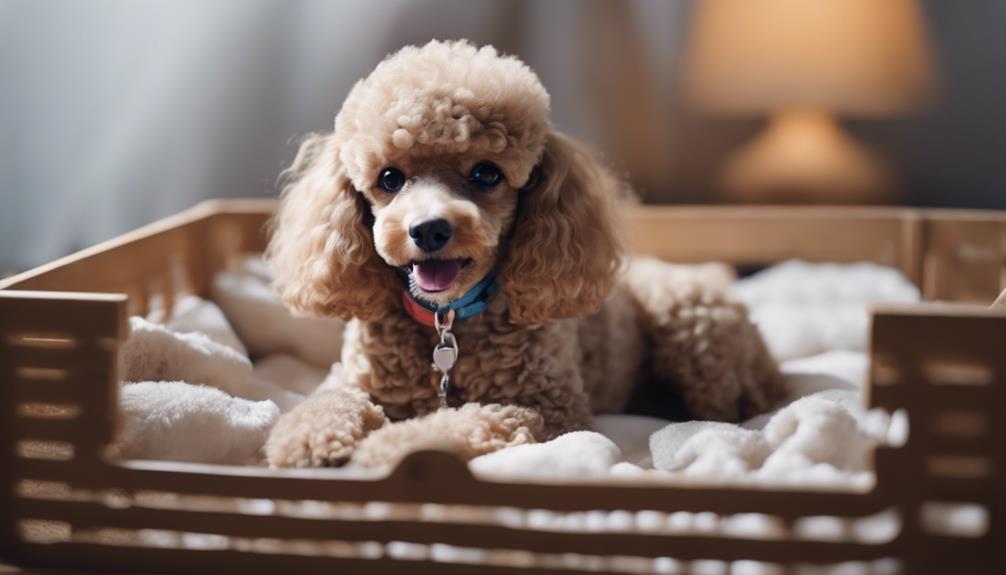
Consider incorporating the use of an article determiner to enhance the readability and understanding of the feeding process within the crate. Feeding your Poodle in the crate can establish positive associations with the space, fostering a comfortable environment for meal times. Placing your Poodle's food and water bowls inside the crate during feeding can aid in making them feel secure and relaxed, thereby preventing food guarding or aggression during meals, ultimately creating a peaceful eating environment for your Poodle. This practice also helps regulate your Poodle's eating pace, reducing food-related anxiety or stress. Consistent feeding in the crate reinforces positive behavior and routine, contributing to an overall enhanced crate training experience.
| Crate Feeding Tips | Benefits |
|---|---|
| Use the crate for meal times | Creates positive associations |
| Place food and water bowls in the crate | Establishes a comfortable environment |
| Prevents food guarding or aggression | Promotes a peaceful eating environment |
| Controls eating pace and reduces anxiety | Reinforces positive behavior and routine |
Gradual Increase in Crating Periods

As you continue crate training your Poodle, gradually extend the time your furry friend spends in the crate each day. Start by adding just a few extra minutes to their crating periods to help them adjust at a comfortable pace. Monitoring their behavior and comfort level is essential during these extended crating sessions to ensure they are adapting well.
Slowly Extend Crating Time
To gradually extend crating time for your Poodle, begin by crating them for short periods and gradually increasing these durations to prevent anxiety or distress. Monitoring your Poodle's behavior and comfort level during each crating session is essential to ensure a positive experience. Consider using treats, toys, and comforting items inside the crate to create a pleasant association with extended crating periods. Slowly extend crating time over days or weeks, allowing your Poodle to acclimate and feel secure in the crate. Remember, consistency and patience are key in gradually increasing crating periods to help your Poodle adjust comfortably.
- Monitor behavior and comfort level
- Use treats, toys, and comforting items
- Slowly extend crating time
- Ensure a positive experience
- Practice consistency and patience
Patience in Crating Schedule
Start gradually increasing crating periods for your Poodle by beginning with short intervals and extending them over time to prevent stress or anxiety. Monitor your Poodle's comfort level and behavior during the adjustments to ensure positive adaptation. Aim for small increments in crating time, like adding 15-30 minutes daily, to help your Poodle acclimate to longer periods in the crate. Consistency is key in the crating schedule to establish a routine, making your Poodle feel secure and comfortable in their crate. Remember, patience is essential when implementing a gradual increase in crating periods. This allows your Poodle to adjust at their own pace and build a positive association with the crate.
| Patience | Crating Schedule | Gradual Increase |
|---|---|---|
| Consistency | Comfort Level | Behavior |
Crating Your Poodle When Leaving
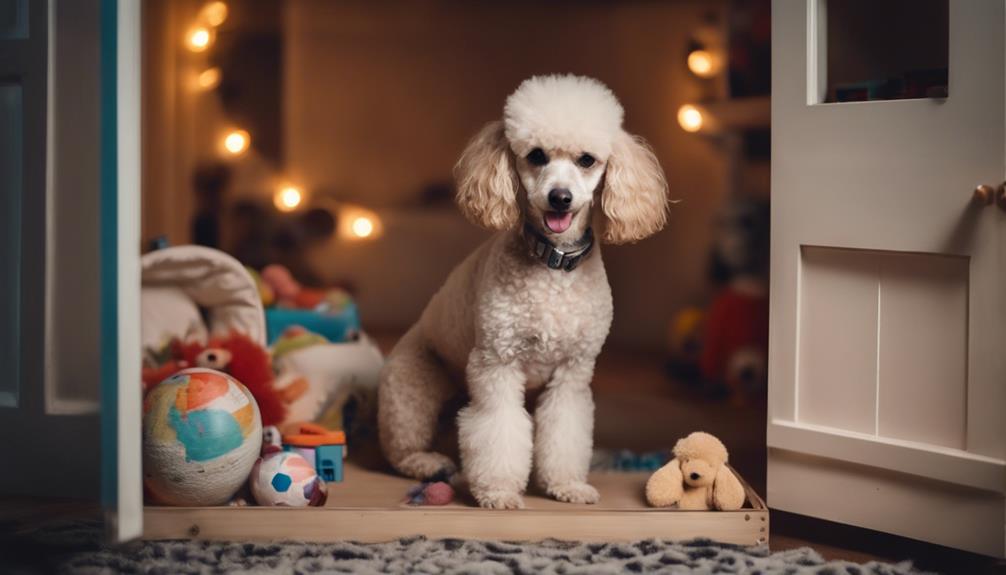
When leaving, consider crating your Poodle to prevent destructive behaviors and ensure their safety and comfort. Crating your Poodle when leaving offers several benefits:
- Preventing Destructive Behaviors: Crating helps avoid issues like chewing or soiling in the house.
- Providing a Safe and Secure Environment: The crate acts as a secure space for your Poodle while you are away.
- Alleviating Separation Anxiety: Crates offer a den-like environment that can help ease separation anxiety in Poodles.
- Establishing Routine and Security: Using a crate when leaving establishes a routine and gives your Poodle a sense of security.
- Ensuring Safety and Peace of Mind: Crating your Poodle when leaving not only keeps them safe but also gives you peace of mind knowing they are secure.
Nighttime Crating for Poodles

When it comes to nighttime crating for your poodle, consider the benefits of providing a quiet sleep environment, a safe containment option, and a helpful aid in potty training. Creating a secure space for your poodle at night can help establish a routine and reduce anxiety, leading to better behavior and improved rest for both you and your furry friend. By utilizing nighttime crating effectively, you can support your poodle's well-being and training progress.
Quiet Sleep Environment
For poodles, creating a tranquil sleep environment through nighttime crating can significantly enhance their rest and well-being. Nighttime crating helps poodles feel safe and secure, reducing anxiety and promoting a sense of routine. It prevents them from engaging in disruptive behaviors like barking or roaming. Proper nighttime crating aids in housebreaking and establishing a healthy sleep schedule. This practice also creates a positive association with their crate, making it a cozy retreat for restful nights.
- Nighttime crating promotes a quiet sleep environment.
- It helps poodles feel safe and secure.
- Reduces anxiety and promotes routine.
- Prevents disruptive behaviors.
- Creates a cozy retreat for restful nights.
Safe Containment Option
Opt for nighttime crating as a safe containment option for your poodle's rest and security. Nighttime crating provides a secure environment for your poodle to rest and sleep peacefully. It helps with potty training by preventing accidents during the night, promoting good habits. Dog crates offer a den-like space that appeals to your poodle's natural instincts for safety and security, reducing anxiety and promoting relaxation. By establishing consistent nighttime crating routines, you can enhance your poodle's behavior and overall well-being. Remember, creating a safe and comfortable space for your poodle at night is essential for their development and happiness.
Potty Training Aid
To help with potty training your Poodle, incorporating nighttime crating can be an effective method to limit accidents and establish a routine for their bathroom needs. Nighttime crating is a valuable tool in your potty training arsenal. Here are some tips to make the most of this strategy:
- Understand that puppies have smaller bladders and may need nighttime bathroom breaks.
- Consistent nighttime crating helps establish a routine for your Poodle's bathroom needs.
- Gradually increase crate time at night as your Poodle grows older and gains bladder control.
- Use positive reinforcement and rewards to encourage your Poodle to associate the crate with potty training success.
- Remember to be patient and consistent in your approach to crate training and potty training.
Troubleshooting Common Crate Training Issues
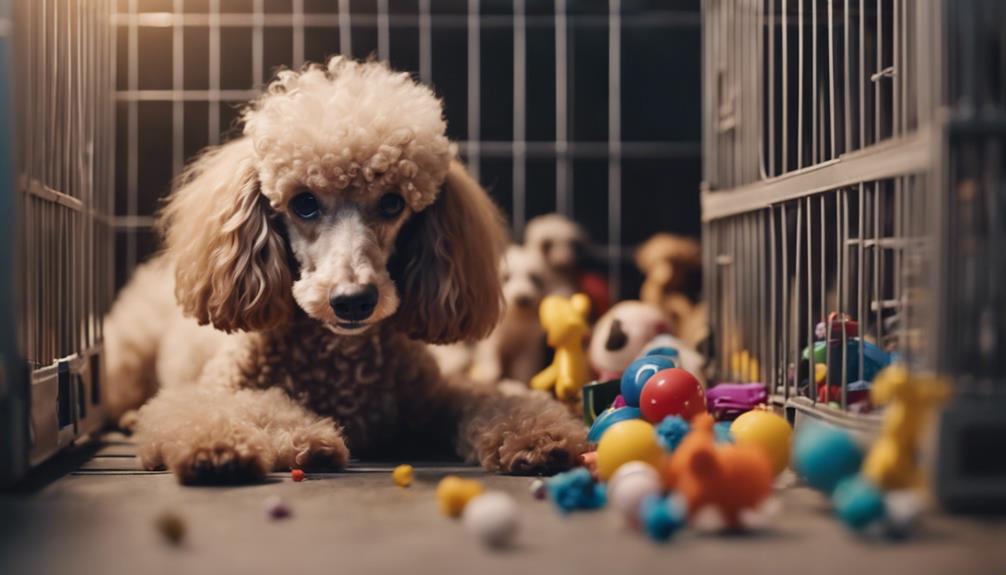
To troubleshoot common issues in crate training, start by addressing excessive whining or barking through the gradual increase of time spent inside the crate and ensuring a comfortable environment. Combat crate aversion by associating the crate with positive experiences, treats, and toys. Handle separation anxiety issues by implementing gradual departures and arrivals to desensitize the dog. Prevent crate escape attempts by securely locking the crate and providing mental stimulation inside. Tackle crate soiling problems by adhering to a consistent potty schedule and cleaning accidents promptly.
| Common Crate Training Issues | Solutions |
|---|---|
| Excessive Whining or Barking | Gradually increase time in crate, ensure comfort |
| Crate Aversion | Associate crate with positive experiences, treats, toys |
| Separation Anxiety | Gradual departures and arrivals to desensitize |
| Crate Escape | Securely lock crate, provide mental stimulation |
| Soiling Problems | Consistent potty schedule, prompt cleaning |
Frequently Asked Questions
Should I Crate Train My Poodle?
Yes, you should crate train your Poodle. It helps with potty training, reduces separation anxiety, and creates a safe space for them. Make sure to choose the right size crate, introduce it gradually, and use accessories for comfort.
How Does Crate Training Help a Dog?
Crate training helps your dog by reducing anxiety, providing a safety measure, aiding in potty training, offering a comfort zone, ensuring travel convenience, promoting independence training, and managing behavior effectively. It's a holistic approach to your dog's well-being.
Does Crate Training Improve Dog Behavior?
Crate training improves dog behavior through behavior modification, positive reinforcement, and training consistency. It reduces anxiety, provides a safe space, aids in potty training, and offers travel convenience. Your poodle will benefit from a well-structured crate training routine.
What Are the Benefits of Dogs Sleeping in Crates?
Sleeping in a crate provides comfort and security for your dog, ensures training consistency, prevents accidents, eases separation anxiety, offers travel convenience, aids behavior modification, and establishes a healthy sleep routine for overall well-being.
Conclusion
In conclusion, crate training your poodle can greatly benefit their well-being and overall behavior. By providing a safe and comfortable space for your pet, you can help reduce stress and create a sense of security. While crate training may require patience and consistency, the long-term advantages for your poodle are well worth the effort. Remember, seek guidance from a professional dog trainer to ensure successful implementation and a happy, well-adjusted pet.
